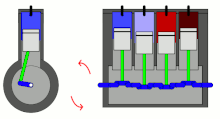Four-cylinder engine
The four-cylinder engine , also four-cylinder called, is a type of reciprocating - motors , in particular from internal combustion engines .
description
Types
It is usually designed as an in- line or boxer engine , more rarely as a V-engine and can be designed as both a gasoline and a diesel engine . In car construction it is mostly water-cooled , in some cases (especially as a boxer engine) it is also air-cooled .
The design of modern four-cylinder engines in the automotive sector is increasingly influenced by lightweight construction, as can be seen, for example, in the compact in-line four-cylinder engines from JLR made of aluminum . So-called Ingenium motors achieve weight savings of up to 80 kg compared to direct predecessor models. In addition, the trend in the design of the current four-cylinder in the automotive industry is towards cross-model configurations and components - the so-called common parts strategy . It makes it possible to save costs through standardized production processes and to integrate future technologies more easily. A well-known example of this is the modular transverse matrix (MQB) from Volkswagen AG or the scalable product architecture (SPA) from Volvo . The Ingenium engines are also based on a modular architecture and have identical dimensions for stroke, bore, cylinder spacing and volume, for example.
A special feature is the arrangement as a "square motor", consisting of two parallel two-cylinder blocks with two crankshafts. This design was only used in a few vehicles, such as B. the Ariel Square Four or the Suzuki RG 500 Gamma .
Applications
Four-cylinder engines are the most commonly used drive systems for mid-range cars because they are relatively compact and fully cover the driving performance required in everyday life. They are also used in the upper middle class and in sports cars in the displacement classes up to 2, more rarely up to 2.5 liters. For some years now, vehicles with a displacement of less than 1.5 liters have increasingly been equipped with three-cylinder engines instead of the previous four-cylinder ones.
Four-cylinder engines are still often used in motorcycles , light trucks , light rail vehicles , light aircraft (boxer engines of the American design), small ships (also as auxiliary engines ), as generator drives and in other applications.
Smoothness
Four-stroke, four-cylinder in-line engines have free inertia forces of the 2nd order, which unfavorably also coincide with the ignition frequency. The forces can, however, be compensated with two counter- rotating balance shafts rotating at twice the crankshaft speed ( Lanchester compensation ). The two possibilities of the firing order
(1-3-4-2 or 1-2-4-3) differ in the location and direction of the inertial forces, but not in their smoothness.
Other uses
Apart from internal combustion engines, there are also four-cylinder, u. a. as piston pumps or compressors .
literature
- Jan drummans: The car and its technology , 1st edition, Motorbuchverlag, Stuttgart, 1992, ISBN 3-613-01288-X
- Hans Jörg Leyhausen: The master craftsman's examination in the automotive trade part 1 , 12 edition, Vogel Buchverlag, Würzburg, 1991, ISBN 3-8023-0857-3
Web links
Individual evidence
- ↑ New Ingenium engine series from Jaguar Land Rover. springerprofessional.de, July 14, 2014, accessed June 17, 2015 .
- ↑ Electromobile drive technology from the modular system. Konstruktionspraxis.vogel.de, July 29, 2011, accessed on June 17, 2015 .
- ↑ VW's auto construction kit for the future. auto-motor-und-sport.de, September 6, 2013, accessed on June 17, 2015 .
- ↑ The new Volvo XC90 - scalable product architecture (SPA). media.volvocars.com, August 12, 2014, accessed June 17, 2015 .
- ↑ New Ingenium engine series from Jaguar Land Rover. springerprofessional.de, July 14, 2014, accessed June 17, 2015 .
- ↑ http://www.e31.de/engines.html

